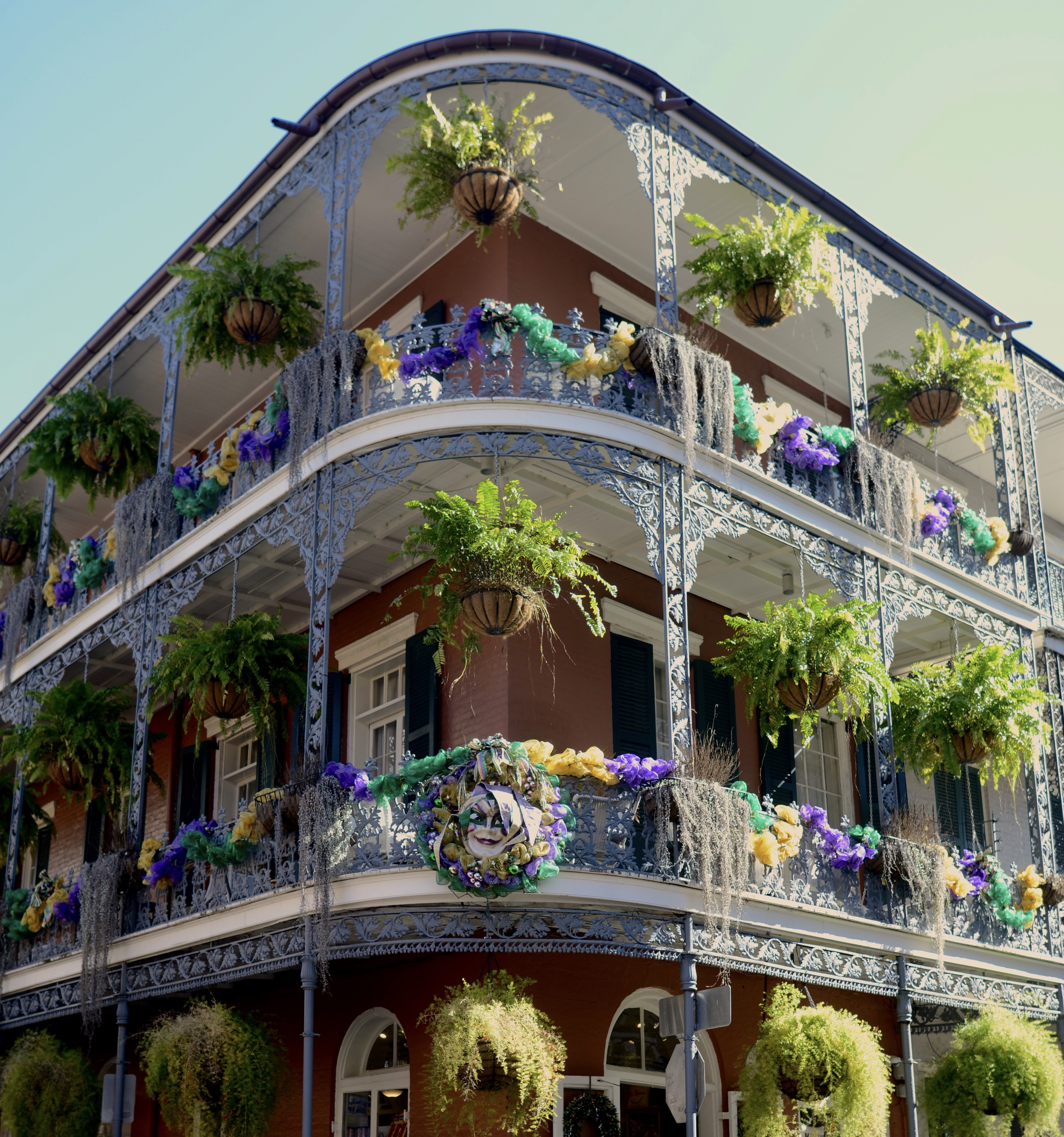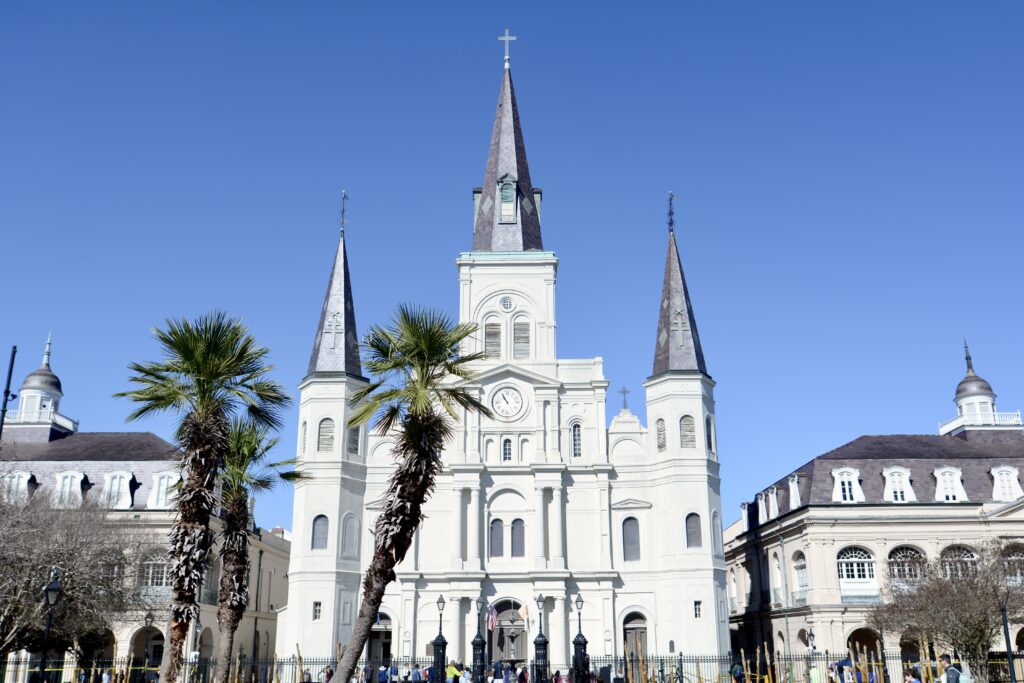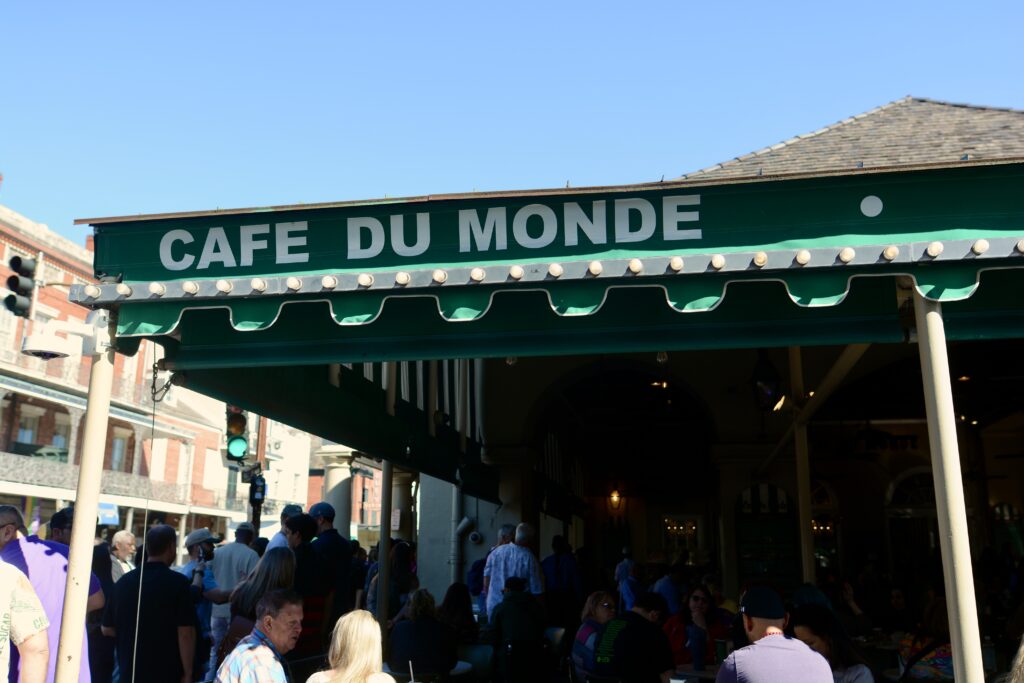
New Orleans gets a bad reputation. It’s known for partying too hard and hard-hitting hurricanes that have devastated the city. But since Hurricane Katrina and the pandemic, New Orleans has bounced back and blossomed.
From the French Quarter to the Garden District, New Orleans has charm. New Orleans may be a little rough around the edges, but it makes its hidden gems even that much more charming. Its Southern soul and historic French charm keep me wanting to come back to New Orleans again and again. In this guide, we’ll go over the must-sees and dos in New Orleans to help you plan your trip down to the Big Easy.
NEW ORLEANS HIT LIST
Wander around the French Quarter

The French Quarter is the historic heart and cultural center of New Orleans. It has charming architecture with iron-clad balconies and colorful homes. Music fills the air with jazz musicians on street corners and music bumping from bars on Bourbon St. Although Bourbon St. is located here, the French Quarter is much more than partying. It has high-end cocktail bars like Fives and cute mom-and-pop shops. Walk around the French Quarter by day and night to get a real feel for its energy.
Visit Jackson Square

In the French Quarter, you’ll find Jackson Square, a historic open-air square near the Mississippi River. When you type in “New Orleans” in Google, this is the image that pops up. The famous backdrop of Jackson Square is St. Louis Cathedral. You visit Jackson Square for the chance to say “Hey, I’ve been there” and admire the make-shift gallery that’s displayed on Jackson Square’s iron fence by local artists.
Eat beignets at Cafe du Monde

Across the street from Jackson Square, you’ll find Cafe du Monde, the famous beignet bakery. Beignets are pillows of fried dough that are reminiscent of funnel cake. They’re covered in powdered sugar, so be ready to make a bit of a mess.

It’s only $3.85 for three beignets. Cafe du Monde is cash only but if you forget to bring cash there’s an ATM in the store across the street. There will most likely be a line for a table in the outdoor bakery but it moves quickly. If you don’t care to sit down, there’s a to-go window on the far side of the cafe, but eating there is truly a New Orleans experience.
Get drinks on Bourbon St.

Bourbon Street is notorious for partying and drinking. Even if that’s not your scene, you need to walk down the entirety of Bourbon St. at least once. While you walk down Bourbon look out for beads falling from the sky as they’re thrown off balconies for people to catch below. The best places to stop in for a sugary and Instagrammable cocktail are Pat O’Briens for a Hurricane (pictured) and Tropical Isle for a Hand Grenade.
Listen to live music on Frenchmen St.

Frenchmen St. is Bourbon St.’s cooler, less commercial counterpart. It’s a live music destination with jazz playing seven nights a week. When you think of jazz, you probably think of a quartet with a guy on the saxophone playing old tunes. Musicians on Frenchmen St. perform jazz renditions of modern songs that will have you singing and dancing along.

The famous live jazz venue The Spotted Cat Music Club sits at the end of the street and charges $10 cover. If you want to avoid paying cover, I recommend going to the small yet soulful Apple Barrel Bar or 30°/-90°.
Ride the cable car through the Garden District
Hop on a Cable Car on Canal St. to ride through the Garden District on St. Charles Ave. The Garden District is home to beautiful streets lined with oak trees and historic buildings.
Shop local art markets

New Orleans has a bustling arts scene. There are a bunch of open-air markets that pop up throughout the city. At the edge of the French Quarter near the French Market is the Disco Warehouse Artist Market on Decatur St. with vintage and handmade pop-ups. At night, the Frenchmen Art Bazaar is open from 7 p.m. to midnight on Frenchmen St. near The Spotted Cat Music Club. Here, you’ll find a lot more handmade goods.
Savor the local food scene

New Orleans cuisine is a mixture of Cajun, Creole, and Southern soul food. While you’re in town try local staples like gumbo, red beans and rice (pictured), and po’boys.
At Central Grocer or Napoleon House, you can try a Muffuletta which is a Sicilian-immigrant sandwich that’s like an Italian sandwich with olives. Modern New Orleans food culture has been shaped by immigrants from places like Southeast Asia and Latin America.
IF YOU HAVE THE TIME
New Orleans City Park
This is a sprawling park with museums, sculpture gardens, and Spanish moss hanging from its endless oak trees. On a nice day, you can bike up Esplanade Ave. to explore it.
Louis Armstrong Park
Visit the birthplace of jazz right outside the French Quarter. Come here to escape the chaos of Bourbon St. and walk across a network of bridges.
The National WWII Museum
Who said New Orleans was all about partying? It may be hard to convince a group to spend the day at the WWII Museum but if you’re into history it’s worth the visit.
Preservation Hall
If you’re a big jazz fan, you need to catch a show at Preservation Hall in the French Quarter. It’s a historic music venue that hosts traditional jazz shows.
The Mississippi River
The Mississippi River is the longest in the United States…not the prettiest. Go to the French Market and cross the street to the bank of the Mississippi to see its muddy waters and say “Been there, done that.”
WHERE TO STAY

There are times to avoid touristy areas and times when you need to embrace them. In New Orleans, you need to be ready to be an unapologetic tourist. The best place to stay in New Orleans is undoubtedly the French Quarter.
The French Quarter is close to everything. It’s the heart of the historic district and is filled with great restaurants, bars, and shops. For a peaceful stay, do not stay on Bourbon St. Bars don’t close until 3 a.m. and people stay on the streets even later than that.
If you can’t find a place to stay in the French Quarter, another great option is the nearby Central Business District. The French Quarter is still within walking distance and it also has some great restaurants.
WHEN TO VISIT

New Orleans is by the Bayou, so it’s hot and it rains a lot. The best time to go is in the winter when the heat isn’t as bad. The good news is that Mardi Gras is celebrated in the winter. For a guide on planning your trip to New Orleans during Mardi Gras, read this blog post.
It’s worth braving the heat to visit New Orleans in May for Jazz Fest. Jazz Fest hosts some of the best musical acts like The Rolling Stones and The Beach Boys for a three-to-four-day music festival.
GOOD TO KNOWS
Getting Around
Most tourist attractions are generally within walking distance of the French Quarter. You can also get around by taking a cable car from Canal St. in the French Quarter. The St. Charles Route will take you to the Garden District and beyond. Ubers are also easy to order and aren’t too expensive.
Safety
Bourbon St. attracts tourists and pickpocketers, especially during festivals like Mardi Gras. Do not put your wallet or phone in your back pocket or backpack. I’ve had multiple friends get their phones stolen, so bring a fanny pack to keep your belongings close.
Walking between the French Quarter and Marigny neighborhood to go to and from Bourbon and Frenchmen St. is safe, but don’t wander into other nearby areas at night.
Some neighborhoods to avoid staying in or walking through alone are Central City, Seventh Ward, and Lower Ninth Ward.
More New Orleans Guides
How To Plan A Trip To Mardi Gras
Other Travel Guides
Weekend Trip To Boston Itinerary
Portland To Acadia National Park Itinerary
Maine Fall Travel Guide: Acadia National Park and Portland
Reply